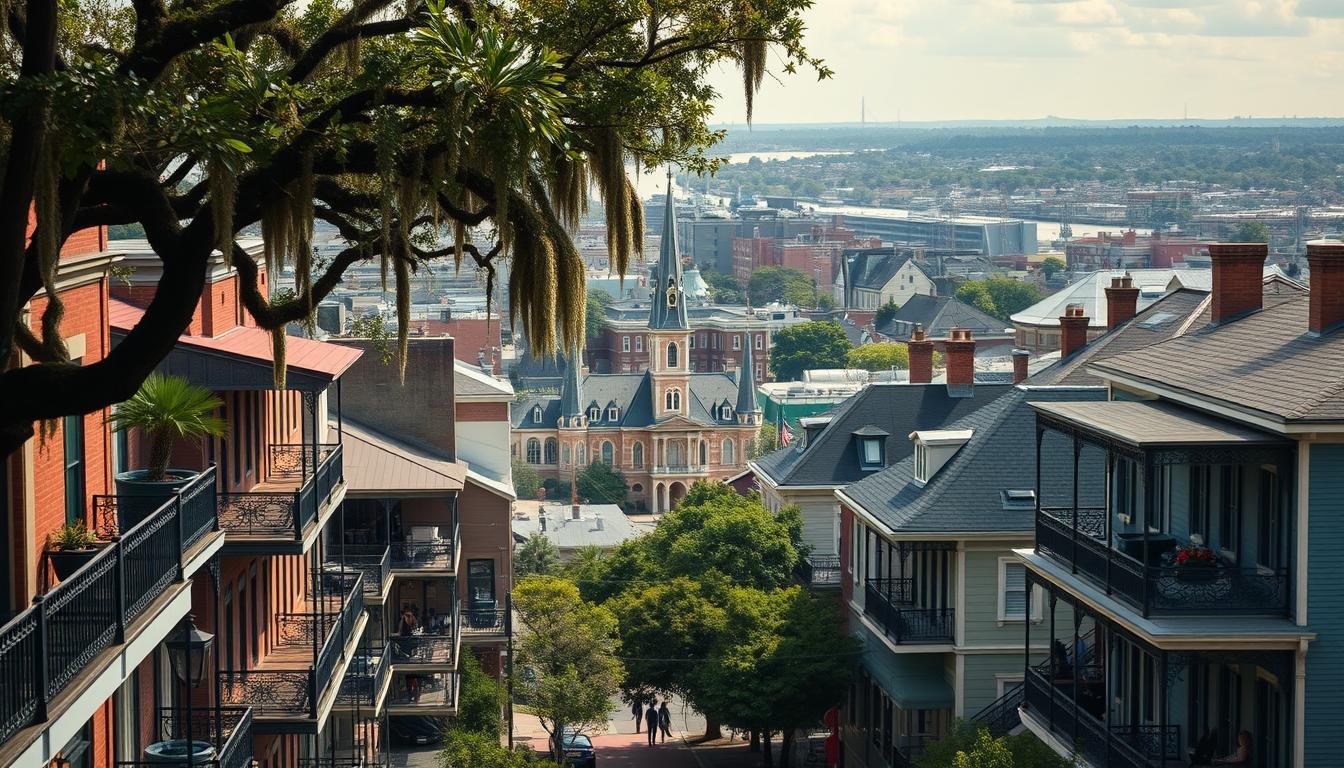As a local, I’m excited to share with you the rich history and cultural significance of New Orleans’ most iconic areas. From the iconic French Quarter to the vibrant Marigny, each neighborhood has its unique character and story to tell.
Exploring these historic districts is like taking a step back in time, discovering the authentic New Orleans experience that makes this city so special. You can start by checking out the neighborhoods guide to plan your journey.
Key Takeaways
- Discover the unique character of New Orleans’ historic neighborhoods
- Explore the rich history and cultural significance of each area
- Learn about the iconic French Quarter and its importance
- Uncover the hidden gems of the Marigny and other neighborhoods
- Plan your journey with the neighborhoods guide
Introduction to New Orleans’ Historic Neighborhoods
As you wander through New Orleans’ historic neighborhoods, you’re not just walking through streets; you’re stepping through layers of history. Each neighborhood is a chapter in the city’s ongoing story, filled with tales of cultural fusion, resilience, and celebration.
New Orleans is a city that wears its history on its sleeve, and exploring its neighborhoods is a great way to experience this firsthand. From the historic homes that line the streets to the vibrant cultural scene that pulses through the air, there’s always something new to discover in NOLA.
Why Explore Neighborhoods?
Exploring New Orleans’ neighborhoods is like taking a journey through time. You’ll uncover hidden gems, from historic homes with stunning architecture to lively street performances that showcase the city’s rich cultural heritage. By delving into these neighborhoods, you’ll gain a deeper understanding of what makes New Orleans so unique.
Whether you’re a history buff, a foodie, or simply someone who appreciates the beauty of diverse cultures, New Orleans’ neighborhoods have something to offer. You can explore the historic preservation efforts that have kept the city’s architectural heritage intact, or you can immerse yourself in the local culture by attending one of the many community events.
A Glimpse into NOLA’s Culture
New Orleans is known for its vibrant cultural scene, which is deeply rooted in its history. As you explore the neighborhoods, you’ll catch glimpses of this culture in the historic preservation efforts, the local cuisine, and the music that fills the air. It’s a city that celebrates its heritage while embracing the future.
From the iconic jazz clubs to the colorful street art, New Orleans is a city that is always alive with energy. By exploring its neighborhoods, you’ll get to experience this energy firsthand and gain a deeper appreciation for the city’s unique cultural identity.
The French Quarter: The Heart of New Orleans
The French Quarter is the pulsating heart of New Orleans, where history and modernity blend seamlessly. As you stroll through its historic streets, you’ll be surrounded by the sounds of jazz, the scent of Creole cuisine, and the charm of centuries-old architecture.
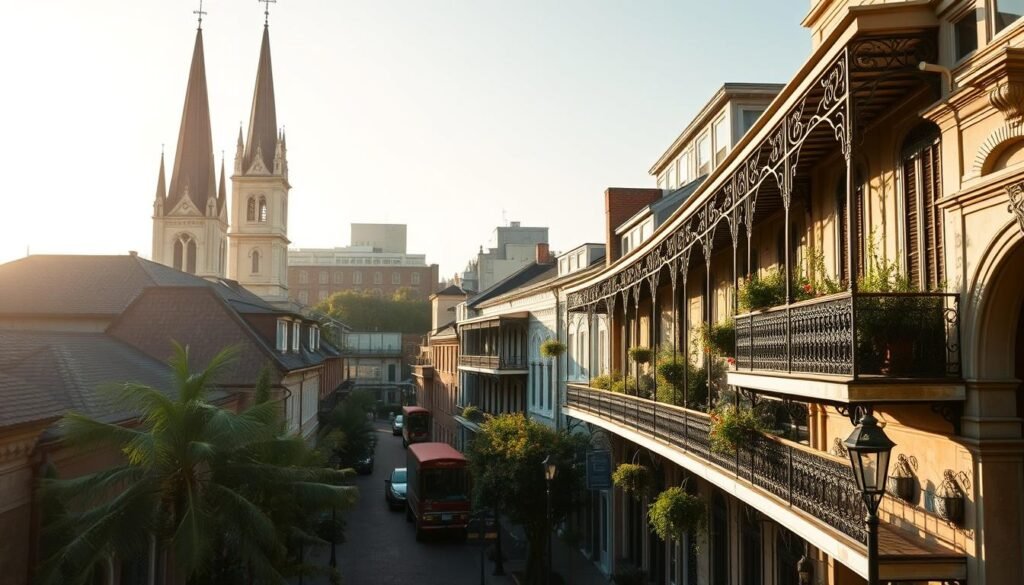
Iconic Jackson Square
At the center of the French Quarter lies Jackson Square, a historic park surrounded by iconic landmarks such as St. Louis Cathedral and the Cabildo. This vibrant square has been the backdrop for countless cultural events, from street performances to festivals.
Jackson Square is more than just a pretty park – it’s a hub of activity where locals and tourists alike gather to soak up the atmosphere, admire the architecture, and enjoy the lively entertainment.
Historic Buildings and Architecture
The French Quarter is renowned for its historic buildings and architecture, showcasing a unique blend of French, Spanish, and African influences. From the ornate balconies to the intricate ironwork, every detail tells a story of the city’s rich past.
As you explore the neighborhood, you’ll discover a mix of architectural styles, including Creole townhouses, historic mansions, and charming cottages.
The Vibrant Atmosphere
The French Quarter is alive with energy, from the lively jazz clubs to the bustling cafes and restaurants. Whether you’re looking for a romantic dinner or a night out on the town, this neighborhood has something for everyone.
The vibrant atmosphere is palpable, with street performers, artists, and musicians adding to the excitement. It’s a place where tradition meets innovation, creating an unforgettable experience for visitors.
The Marigny: A Bohemian Paradise
As a local, I can tell you that The Marigny is the heart and soul of New Orleans’ bohemian culture. This vibrant neighborhood is a haven for artists, musicians, and anyone looking for an authentic New Orleans experience.
The Marigny is known for its live music scene, with numerous venues and impromptu performances on the street. You can hear the sounds of jazz, blues, and rock ‘n’ roll filling the air, creating an infectious energy that’s hard to resist.
Live Music Scene
From famous spots like the Spotted Cat Music Club to impromptu street performances, The Marigny’s live music scene is always buzzing. Whether you’re a musician yourself or just a music lover, you’ll feel the rhythm of the city in this neighborhood.
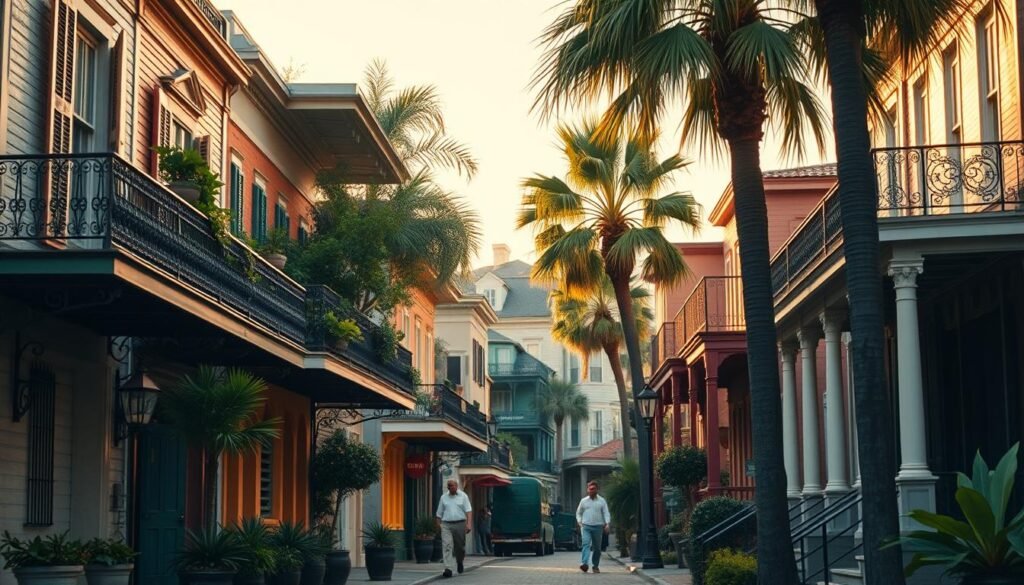
Colorful Shotgun Houses
The Marigny’s architecture is just as charming as its music scene. The neighborhood is filled with colorful shotgun houses, their bright facades and ornate ironwork balconies adding to the area’s unique charm.
These historic homes, some of which date back to the 19th century, have been lovingly restored and now serve as homes, galleries, and shops, adding to the neighborhood’s eclectic vibe.
Unique Culinary Offerings
No visit to The Marigny would be complete without sampling its unique culinary offerings. From traditional Creole cuisine to innovative fusion dishes, the neighborhood’s restaurants and cafes are a foodie’s paradise.
Be sure to try some of the local specialties, like beignets at Cafe du Monde’s Marigny location or a po’ boy sandwich at one of the many sandwich shops. The Marigny’s culinary scene is a true reflection of New Orleans’ cultural melting pot.
The Garden District: A Glimpse of Elegance
As a local, I’ve always been enchanted by the Garden District’s timeless elegance and historic charm. This neighborhood is a treasure trove of architectural and cultural heritage, offering a unique glimpse into New Orleans’ storied past.
The Garden District is renowned for its stunning antebellum mansions, which showcase the city’s rich history and architectural prowess. These grand homes, with their intricate ironwork and sweeping porches, are a testament to the craftsmanship of the era. As you stroll through the district, you’ll notice the unique blend of Greek Revival, Italianate, and Victorian styles, reflecting the diverse influences that have shaped the city’s architecture.
Antebellum Mansions
The antebellum mansions of the Garden District are truly breathtaking, with their elaborate facades and beautifully manicured gardens. These homes were built during the mid-19th century, a period of significant growth and prosperity in New Orleans. Many of these mansions have been meticulously preserved and restored, offering a glimpse into the lives of the city’s former elite.
Oak-Lined Streets
One of the Garden District’s most striking features is its oak-lined streets, which create a canopy of shade and add to the neighborhood’s serene ambiance. These majestic trees, some of which are over a century old, have been carefully preserved and are a defining characteristic of the district.
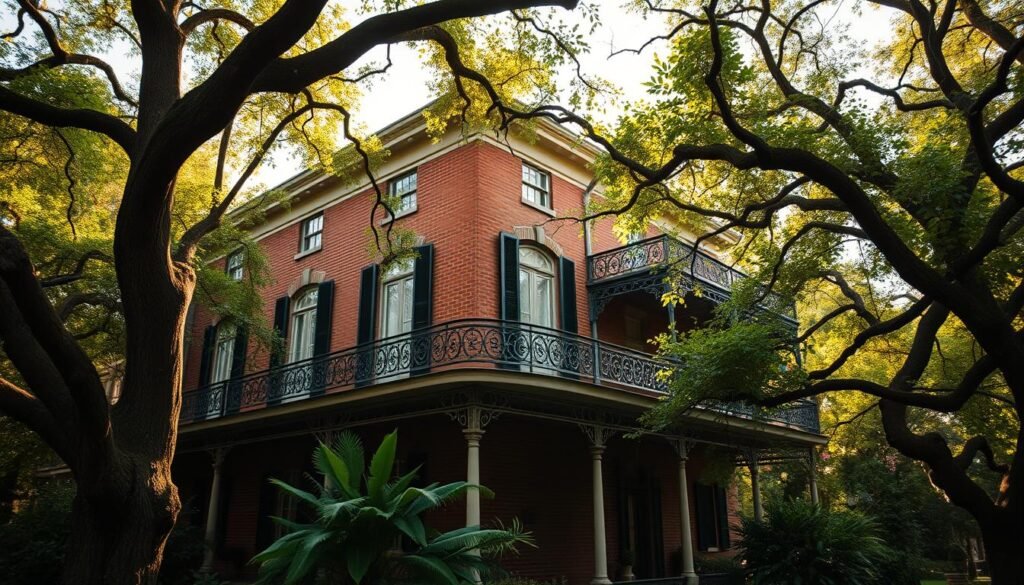
The Lafayette Cemetery
No visit to the Garden District would be complete without a visit to the historic Lafayette Cemetery. This 19th-century cemetery is a fascinating example of New Orleans’ unique approach to burial practices, with its above-ground tombs and ornate mausoleums. As you explore the cemetery, you’ll notice the intricate stone carvings and the way the tombs seem to stretch on forever, creating a hauntingly beautiful landscape.
The Garden District is a true gem of New Orleans, offering a unique blend of history, architecture, and culture. Whether you’re a history buff, an architecture enthusiast, or simply someone who appreciates the finer things in life, this neighborhood is sure to captivate and inspire. As you explore the district, you’ll discover why it’s considered one of the city’s most famous neighborhoods, and a must-visit destination for anyone looking to experience the real New Orleans.
- Take a stroll through the Garden District’s picturesque streets and admire the historic homes.
- Visit the Lafayette Cemetery to explore the unique above-ground tombs.
- Enjoy the local cuisine at one of the many restaurants in the area.
Treme: The Birthplace of Jazz
As a local, I’ve always been drawn to Treme, the neighborhood where jazz was born and where the city’s vibrant culture continues to thrive. This historic neighborhood is a must-visit for anyone looking to explore New Orleans’ history and experience the authentic spirit of the city.
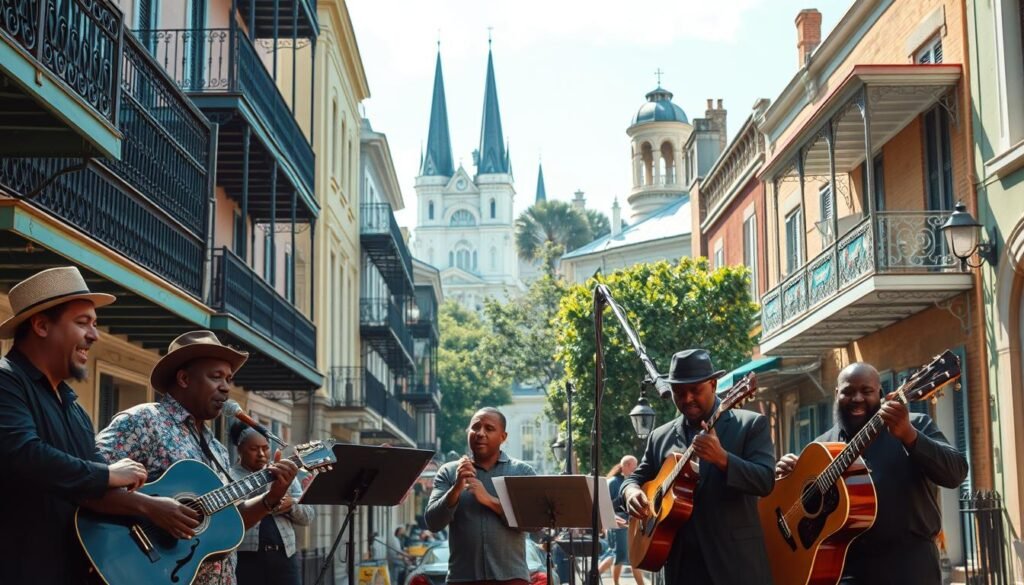
Rich Cultural Heritage
Treme’s cultural heritage is palpable as you walk through its streets. The neighborhood is home to numerous historic sites and institutions that have played a significant role in shaping the city’s musical and cultural identity. From the New Orleans African American Museum to the Backstreet Cultural Museum, Treme offers a deep dive into the history and traditions that make New Orleans so unique.
Famous Landmarks
Some of the most iconic landmarks in Treme include Perseverance Hall and the St. Roch Market. These sites not only reflect the architectural beauty of the neighborhood but also its historical significance. Visiting these landmarks offers a glimpse into the past and helps to understand the present cultural landscape of New Orleans.
Community Events
Treme is known for its vibrant community events, particularly the Treme Creole Gumbo Festival and the French Quarter Festival events that spill into Treme. These events celebrate the neighborhood’s rich heritage and offer a chance to experience the local cuisine, music, and culture firsthand. Whether you’re a local or just visiting, these events are a great way to connect with the community and enjoy the city’s festive atmosphere.
In conclusion, Treme is one of the best neighborhoods in New Orleans for those seeking an authentic cultural experience. Its unique blend of history, music, and community makes it a standout destination in the city’s new orleans historic neighborhoods.
Bywater: Artistic and Eclectic
As you wander through the streets of Bywater, the artistic vibe is unmistakable, making it a unique gem in New Orleans. This neighborhood is a canvas of creativity, where historic homes meet modern artistry.
Bywater is renowned for its vibrant murals and eclectic street art, transforming the neighborhood into an outdoor gallery. The walls here tell stories of the city’s culture, history, and resilience.
Murals and Street Art
The murals in Bywater are more than just decorative; they’re a reflection of the community’s spirit and the city’s rich history. From large-scale murals to smaller, intricate pieces, the street art here is a testament to the neighborhood’s artistic soul.
Some of the murals depict scenes from New Orleans’ history, while others showcase the city’s iconic imagery, such as jazz musicians and Mardi Gras celebrations. Walking through Bywater, you’ll discover these artworks scattered throughout the neighborhood, each one adding to the area’s charm.
Local Shops and Galleries
Bywater is also home to a variety of local shops and galleries, each offering a unique glimpse into the neighborhood’s eclectic character. From vintage clothing stores to art galleries showcasing local talent, there’s something here for everyone.
Many of these businesses are owned and operated by locals, adding to the neighborhood’s authentic feel. Whether you’re looking for a special souvenir or simply want to explore the local culture, Bywater’s shops and galleries are a must-visit.
| Shop/Gallery | Description | Location |
|---|---|---|
| Bywater Art Gallery | Showcases local and regional artists | 1434 St. Roch Ave |
| Vintage New Orleans | Vintage clothing and antique items | 1232 St. Roch Ave |
| Street Art Supply | Art supplies and local art pieces | 2134 N. Rampart St |
Bywater’s blend of historic charm and modern creativity makes it a fascinating neighborhood to explore. Whether you’re an art lover, a history buff, or just looking for a unique New Orleans experience, Bywater has something to offer.
Algiers Point: A Quiet Escape
As you step into Algiers Point, you’re enveloped in a sense of calm, surrounded by stunning river views and beautifully preserved historic homes. This charming neighborhood on the west bank of the Mississippi River is a must-visit for anyone looking to experience the quieter side of New Orleans.
Algiers Point is known for its scenic river views, which offer a unique perspective on the city. The views of the Mississippi River are simply breathtaking, especially during sunrise or sunset when the sky is painted with hues of orange and pink.
Scenic River Views
The river views in Algiers Point are not just visually stunning; they also provide a glimpse into the city’s rich maritime history. You can spend hours strolling along the riverfront, taking in the sights and sounds of the bustling river. Some key spots to enjoy these views include:
- Riverwalk
- Algiers Point Ferry Terminal
- Various parks along the riverfront
Historic Homes and Architecture
Algiers Point is also renowned for its historic homes and architecture, showcasing a mix of styles that reflect the neighborhood’s rich history. From Creole cottages to Victorian-era homes, the architecture here is a testament to the city’s cultural heritage. For those interested in historic preservation, Algiers Point is a great example of how New Orleans maintains its historic neighborhoods. You can learn more about the city’s preservation efforts in the Historic Districts guidelines.
Some notable features of the historic homes in Algiers Point include:
- Intricate ironwork
- Colorful facades
- Beautifully maintained gardens
Visiting Algiers Point is like stepping back in time, with its picturesque streets and historic homes creating a serene atmosphere that’s a perfect escape from the city’s more vibrant neighborhoods.
The Warehouse District: Blend of Old and New
The Warehouse District is one of those neighborhoods that perfectly encapsulates New Orleans’ ability to blend the old with the new. As you walk through its streets, you’re surrounded by historic warehouses that have been transformed into modern art galleries, trendy restaurants, and vibrant cultural spaces.
Art Galleries and Museums
The Warehouse District is renowned for its art scene, featuring numerous galleries that showcase everything from contemporary art to historic artifacts. One of the standout attractions is the New Orleans Museum of Art’s Besthoff Sculpture Garden, although it’s worth noting that the New Orleans Museum of Art is actually located in City Park, the Besthoff Sculpture Garden is near the Warehouse District and is definitely worth a visit. More accurately, the Warehouse District is home to the Ogden Museum of Southern Art, which features a comprehensive collection of Southern art from the 19th century to the present.
Some of the galleries and museums in the area include:
- The Ogden Museum of Southern Art
- The Contemporary Arts Center
- Various private art galleries along Julia Street
As an art enthusiast, I can attest that the Warehouse District offers a unique and enriching experience, with its diverse range of artistic expressions and cultural exhibitions.
Trendy Restaurants
The Warehouse District is also a foodie’s paradise, with a variety of trendy restaurants that serve up everything from contemporary Creole cuisine to artisanal coffee. Some popular spots include:
| Restaurant | Cuisine |
|---|---|
| Coop’s Place | Cajun |
| Herbsaint | Contemporary American |
| Café Degas | Creole |
As quoted by a local food critic, “The Warehouse District’s culinary scene is a reflection of New Orleans’ rich cultural heritage, with its unique blend of traditional and modern flavors.”
“New Orleans is a city that wears its heart on its sleeve, and the Warehouse District is no exception, with its vibrant art scene and delicious Creole cuisine.” – Local Food Critic
In conclusion, the Warehouse District is a neighborhood that embodies the spirit of New Orleans, blending its rich history with modern attractions and cultural experiences. Whether you’re an art lover, a foodie, or simply looking to explore one of the city’s most vibrant neighborhoods, the Warehouse District is a must-visit destination.
Tips for Exploring New Orleans’ Historic Neighborhoods
As you wander through New Orleans’ famous neighborhoods, like the French Quarter and the Garden District, you’ll discover the city’s rich history and cultural heritage. To make the most of your experience, consider a few insider tips.
Best Times to Visit
The best times to visit New Orleans’ historic neighborhoods are during the spring and fall, when the weather is mild and comfortable. Avoid visiting during peak summer months if you’re sensitive to heat and humidity. Using a new orleans historic district map can help you navigate the city’s historic areas and plan your visit.
Getting Around
New Orleans is relatively easy to navigate on foot, but you can also use public transportation or ride-sharing services to get around. Be sure to respect local customs and traditions, especially when visiting historic sites and cultural events, to support historic preservation in new orleans.
Respecting Local Culture
New Orleans is known for its vibrant culture and history. When exploring famous neighborhoods in new orleans, be mindful of local residents and businesses, and take time to appreciate the city’s unique heritage.
FAQ
What are the most historic neighborhoods in New Orleans?
New Orleans has several historic neighborhoods, including the French Quarter, Marigny, Garden District, Treme, Bywater, Algiers Point, and the Warehouse District, each with its unique character and cultural significance.
What is the best way to explore New Orleans’ historic neighborhoods?
The best way to explore New Orleans’ historic neighborhoods is on foot or by bike, allowing you to take in the city’s unique architecture, vibrant cultural scene, and rich history.
What are some must-see attractions in the French Quarter?
The French Quarter is home to many iconic landmarks, including Jackson Square, St. Louis Cathedral, and Bourbon Street, as well as numerous historic buildings and architecture.
What makes the Marigny neighborhood so unique?
The Marigny is known for its vibrant live music scene, colorful shotgun houses, and unique culinary offerings, making it a must-visit destination for anyone looking to experience the authentic New Orleans.
Can I visit the historic homes in the Garden District?
Yes, the Garden District is known for its stunning antebellum mansions, and many of these historic homes are open to visitors, offering a glimpse into the city’s rich cultural heritage.
What is the significance of Treme in New Orleans’ history?
Treme is known as the birthplace of jazz, and it’s a neighborhood that’s steeped in cultural heritage, with numerous famous landmarks and community events throughout the year.
How can I experience the city’s vibrant art scene?
The Warehouse District is home to numerous art galleries and museums, making it the perfect place to experience the city’s vibrant art scene, and Bywater is known for its murals and street art.
Are there any historic neighborhoods with scenic river views?
Yes, Algiers Point is a neighborhood that offers stunning scenic river views, as well as historic homes and architecture, making it a must-visit destination for anyone looking to experience the city’s quieter side.
What are some tips for respecting local culture in New Orleans?
To respect local culture in New Orleans, be mindful of the city’s history and cultural heritage, and take the time to learn about the neighborhoods you’re visiting, and be respectful of local customs and traditions.
Where can I find a map of New Orleans’ historic districts?
You can find a map of New Orleans’ historic districts online or at local visitor centers, which can help you navigate the city’s many historic neighborhoods and districts.
